How Quip's Engineering Team Uses Quip
If you asked our engineers what tools they used at previous companies to get their work done, you'd get answers from wikis, to IRC, to Google Docs, to post-it notes on whiteboards. Every company has its own cobbled-together collection of products — often a mix of internal and external tools — to help engineers be productive. What you'll also hear is that there was a huge amount of inconsistency, even at the same company. One engineering team would communicate via email, while another did their coordination using a wiki page. Some design docs are sent out as Word Files, others kept in Google Docs. There was a lot of complexity to manage — a lot of "work" involved in just getting work done.
At Quip, things have been different. We use Quip for virtually every part of planning, work tracking, and communication. While we still rely on products like GitHub and Zendesk for our bug database and outbound support, Quip itself is simple and flexible enough to have replaced a host of other tools to support what we do everyday.
Every stage from design to launch
Our engineers rely on Quip to build Quip. And they've found one of the most distinctive aspects of Quip — that each document has a corresponding messaging thread — to be extremely powerful. Nowhere is this more evident than when a new feature or piece of functionality is in the design stage. Someone will create a design doc and rather than posting it somewhere or sending it out for review and then trying to make sense of the comments that dribble in via email, he'll simply add it to the Design Docs folder, which automatically shares it with the whole team and opens the door for collaboration and discussion.

Revisions can happen directly on the document, sometimes taking place quickly as a result of the instantaneous feedback, and when the document is finalized, there is also a log of all the changes and discussions along the way.
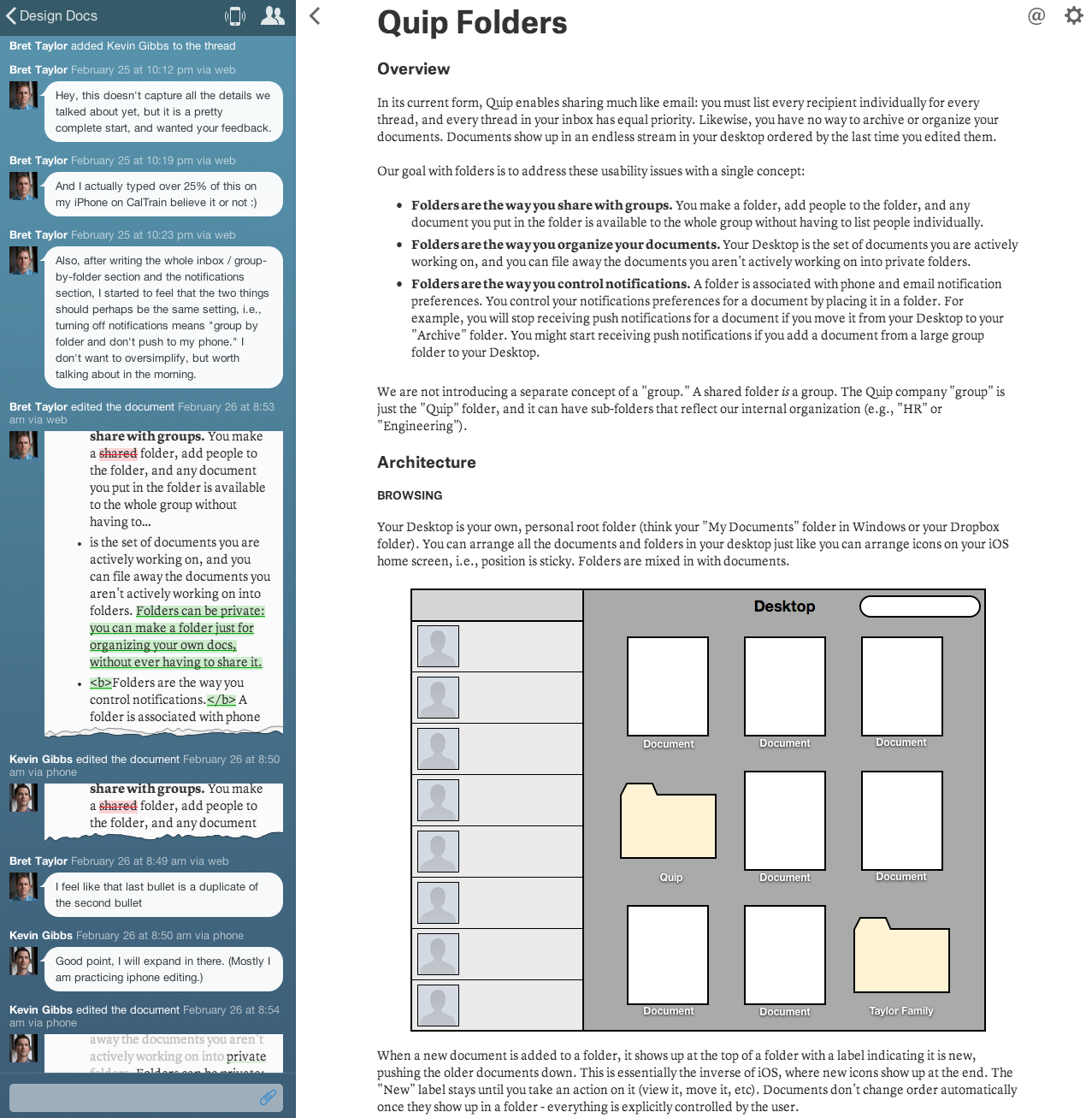
Once a design has been nailed down, the engineer working on the feature creates a list of the specific implementation tasks required. Each major feature we work on has its own task list. And because Quip offers the ability to quickly and easily turn text into a checklist, each task list is simply its own document, which means that the engineers don't have to go to a separate product for project management.

The team uses @mentions to assign owners to sections or items in the list. People can see at-a-glance who is responsible for what. The checklist format also makes it really easy to follow along on progress. If one engineer is blocked on something that another person needs to implement first, they can immediately see when it gets done. (It's also very helpful for those of us working on customer and press communications — to see when something has been done or fixed, or to get a sense for how we're tracking on a deadline.)
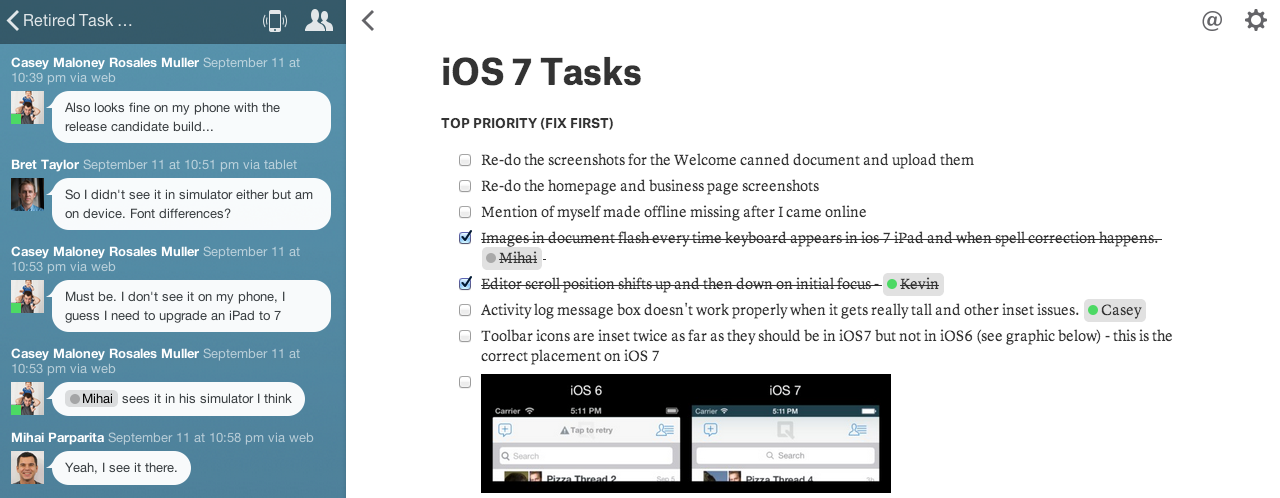
In addition to major features and launches, the engineering efforts at Quip are broken down into a series of three-week milestones. There is a corresponding task list for each milestone. Small tasks are listed directly in the milestone's task list. For more complicated features, like our full Android application, there will be an @mention to the corresponding feature's task list.
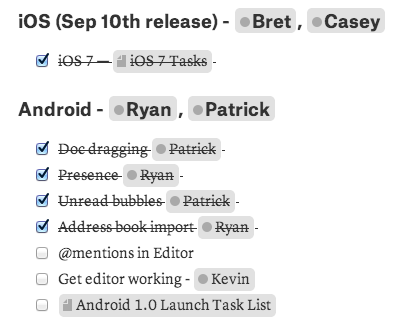
The task list serves as the project management tool, but naturally also becomes the place where bugs get surfaced. We rely on GitHub for tracking random bugs we encounter, but when it's an issue in an area where another engineer is actively working, it's actually more productive to surface it in relevant the task list instead.
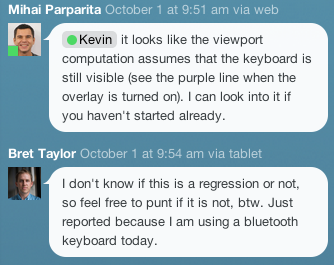
This makes it easy to see if regressions are known in areas that are rapidly changing, and because of the natural conversations that arise when the messaging thread is part of the document, the task list itself becomes the perfect place for a quick discussion of the correct behavior and how to fix it.
When it's time to actually launch the feature, Quip becomes the best tool for release coordination as well. Conversations happen on the task list, or in the Engineering thread that everyone is part of. Everybody is usually already working on some document or other within Quip, so they can easily follow along on conversations via notifications and chat tabs, without having to constantly switch back and forth to another product. And with several of our team members having long commutes via public transportation, it means they can stay in the loop on a launch from anywhere, and keep their task lists up to date even without internet access.
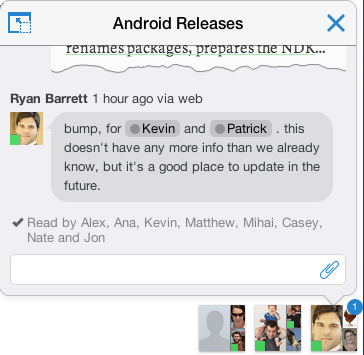
When a task list is finished, it gets filed into the Retired Task Lists folder, which serves as an archive of the implementation of every feature we've built, complete with details of exactly who did what, in what order, and any issues that arose for discussion.
Intranet, research repository, design library and more
In addition to using Quip day-to-day for managing a launch or splitting up work on a feature, we've also come to rely on Quip for practically everything else. We keep a single document with the agenda and notes from our weekly engineering meetings. Before each one, folks will contribute discussion topics, which bubbles the document up to the top of everyone's Inbox. Weekly user stats and other relevant graphs are also added, which means that this document becomes an ongoing log of our vital statistics, as well as what we worked on, from week to week.

We also heavily depend on folders (and a few folks who like to keep all our folders and documents well-organized). There's a "Research" folder with documents for tricky tasks like how to run the server after upgrading to Mavericks, or tables of what Android devices are most popular. This folder doesn't get used every day, but it's there as a permanent store of shared knowledge.
There's another folder where our designer, Matt, uploads screenshots and other files, and new email copy gets hammered out. Quip makes it easy to attach files to threads and to insert them into documents, which makes it easy for our engineers to have access to whatever assets they need for the site at all times.
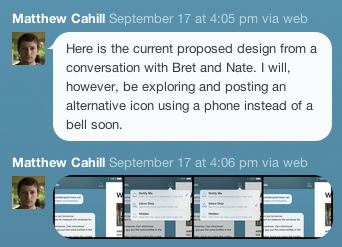
Quip has become not only our intranet, where all company materials are easily accessible via search, but also our mailing lists. Everyone was recently invited to the company Halloween party when a document containing all the details was shared with them.
Quip has emerged as the way everyone keeps themselves up-to-date on different parts of the company, be it the next newsletter that's going to be sent to customers, or the newest forms for benefits enrollment. And it's the way we communicate with one another — we don't use email internally.

Of course, there are only 10 engineers at Quip, and 13 of us total. If we were a much larger company, individual teams would probably use Quip the way we do right now as a company. That's why our engineering team has come to be some of our best test users — seeing how successfully they're using the product has demonstrated Quip's ability to seamlessly fulfill many of an organization's various needs.
The ironic thing is that if you asked one of our engineers how often they used "documents" before Quip, they'd probably say almost never. Before Quip, they juggled a litany of tools to serve different purposes, usually alongside mountains of email. In Quip, our engineers have found (and built) a simple, yet flexible product that makes it easier for them to keep making great products.
Want to share this case study with your team? You can download a copy here. If you're interested in learning more about how to use Quip with your team, send us an email at sales@quip.com.
